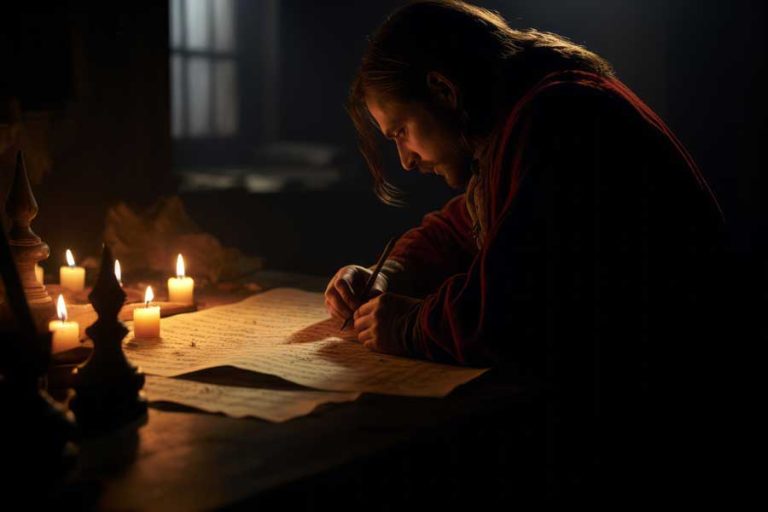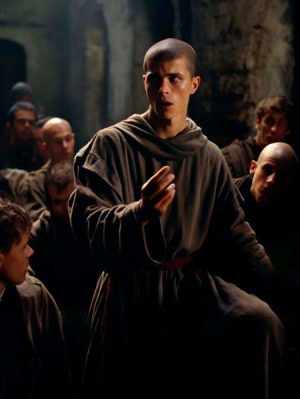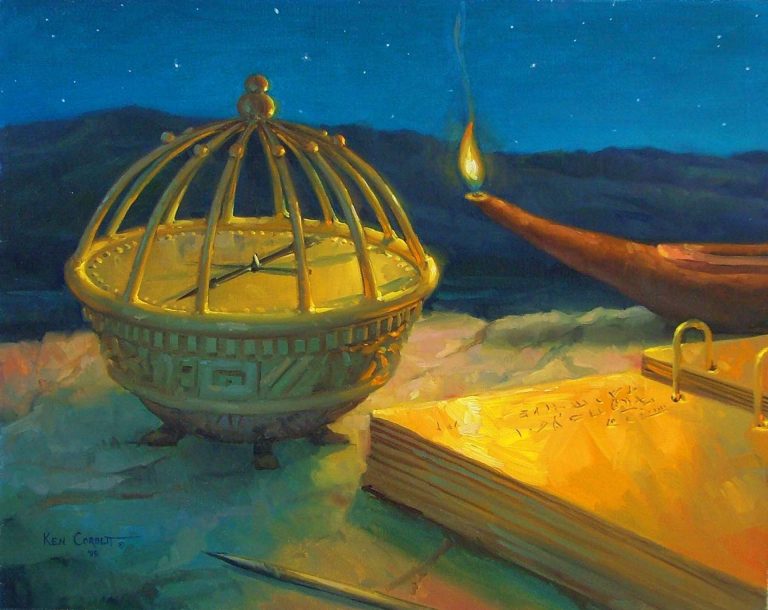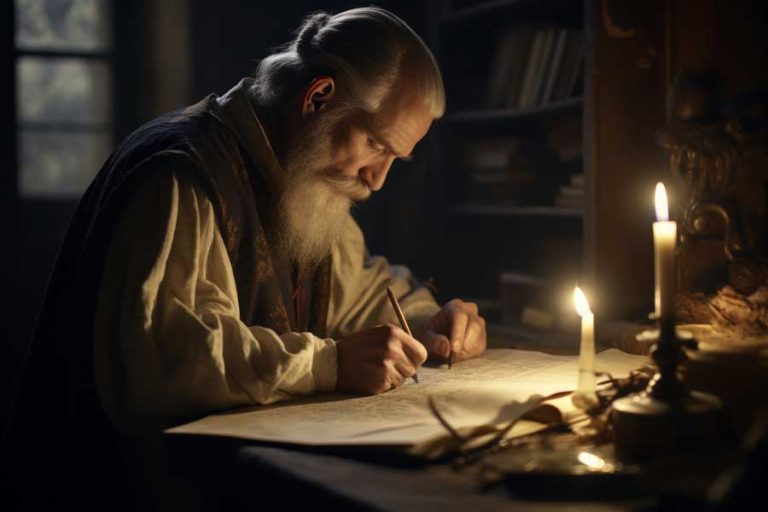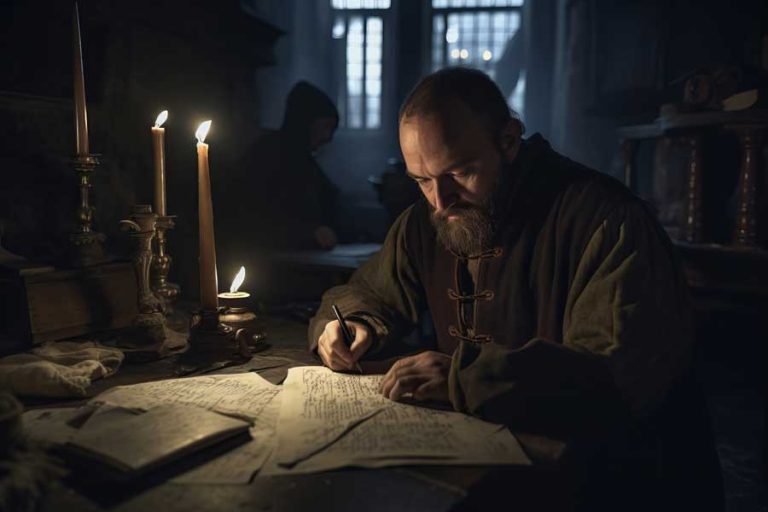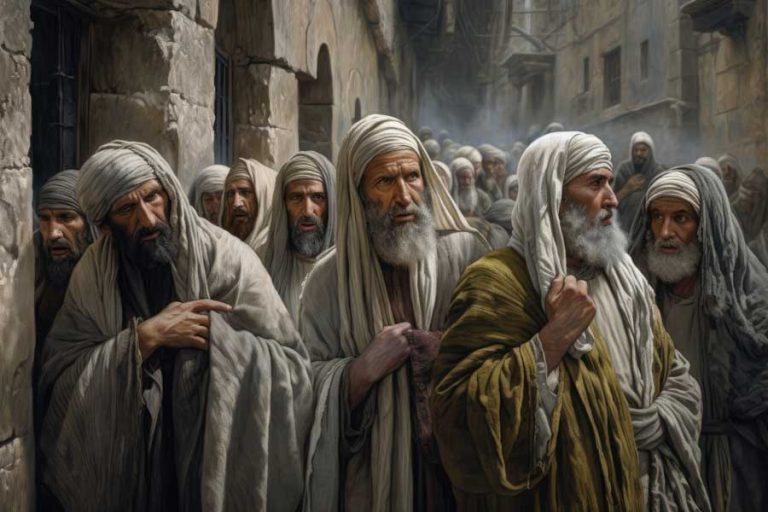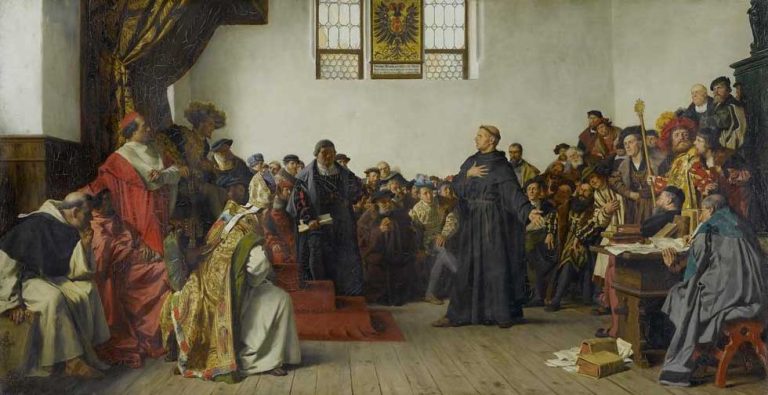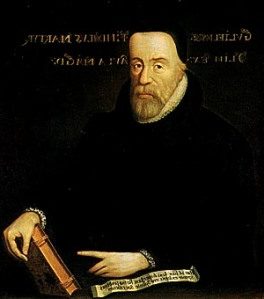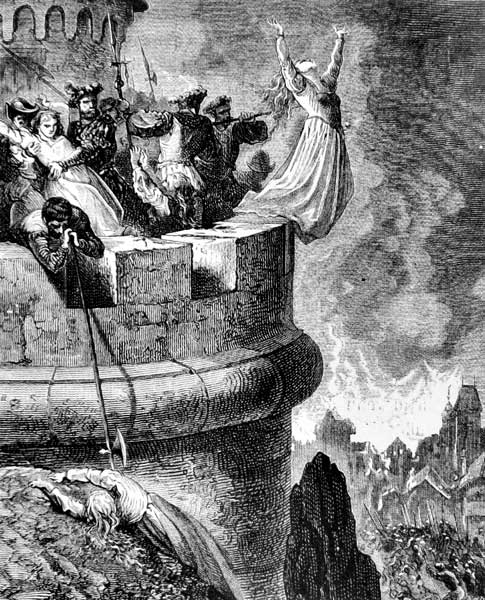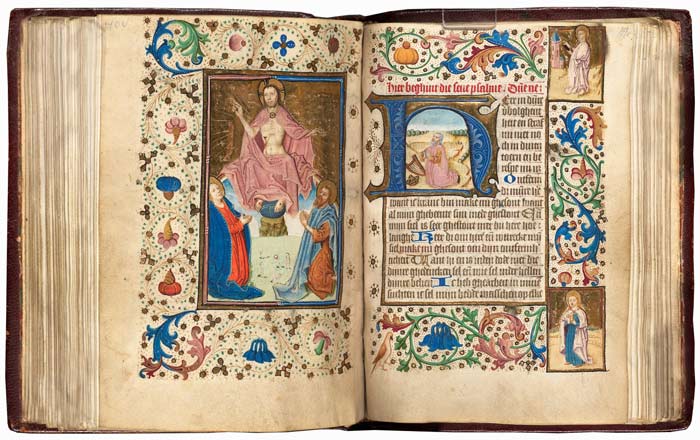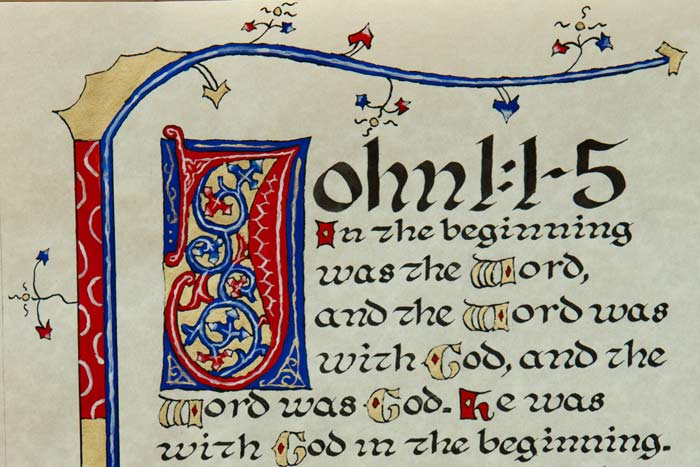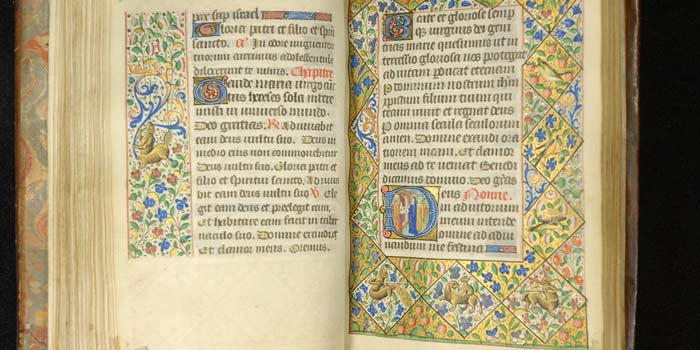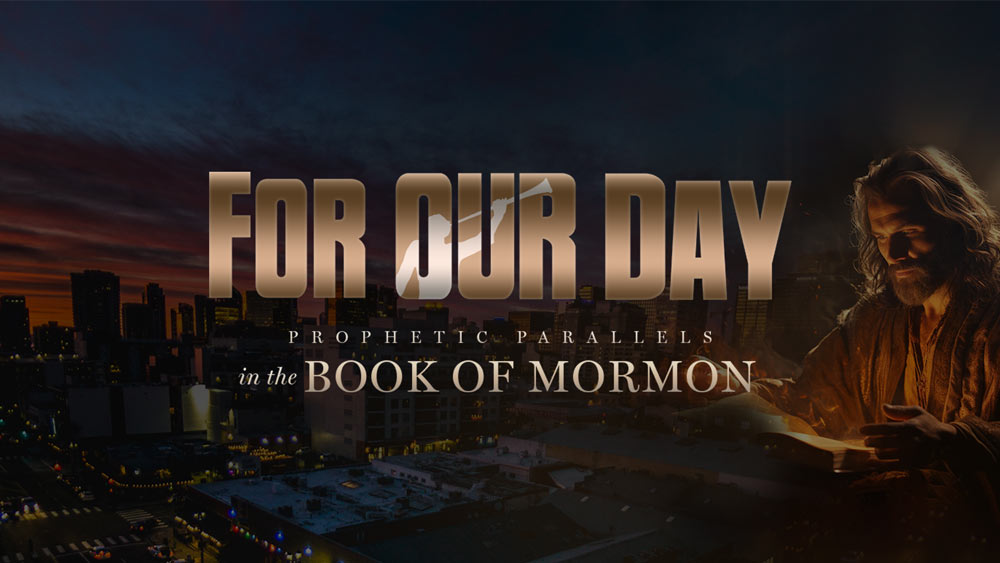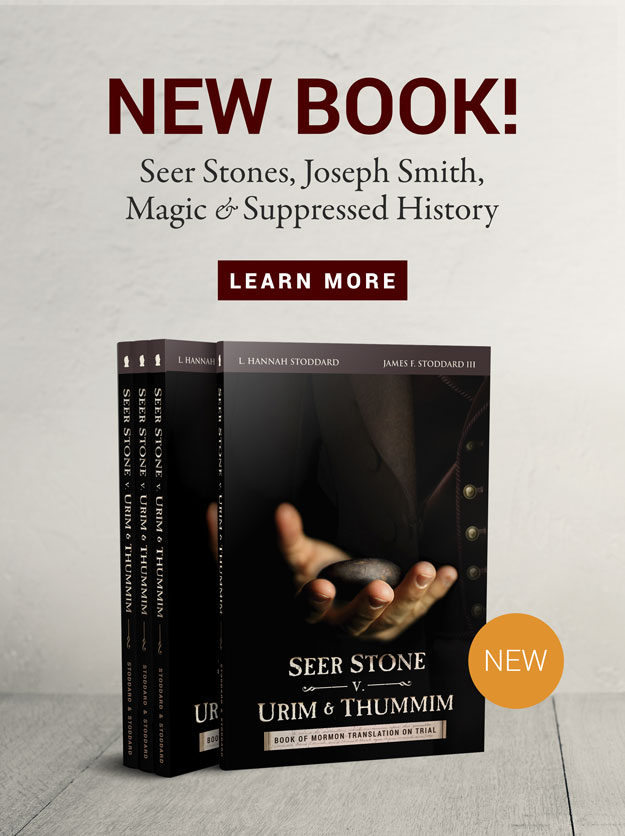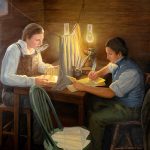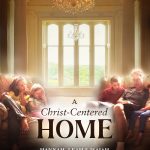Answer the Call
For Our Day Parallel
Book of
Mormon
For
Our Day
Lesson 2: Fighting for Scripture — Lehi & the Reformation Martyrs
Set the Course
The Book of Mormon begins with the prophet Lehi being commissioned by the Lord to preach repentance to the Jews in Jerusalem. The populace of Jerusalem believed itself to be the chosen people of the Lord, but they failed to keep the Lord’s commandments. They rejected and sought the lives of Lehi and the prophets, many being tortured and put to death. The Lord warned Lehi to flee into the wilderness and eventually covenanted to him a promised land (eventually known as America). The Lehites were guided there by the Lord—founding one of the greatest nations in the world’s history on the teachings in a book of scripture known as the Brass Plates.
The history of our modern civilization is a perfect parallel. Our history begins in the blackness of the Dark Ages with great men and women of character standing for ancient truths found in scripture. They stood alone, sustained by the Lord, against an apostate religious darkness which had covered the earth for centuries and claimed to speak for God.
These Reformers were hunted, driven and martyred for the testimony of Christ and His Scripture. Groups were led by God to the New World and given direction to keep the covenant of this land, which is, that all those who possess it will serve the Lord Jesus Christ or they will be swept off. These pilgrims, refugees and covenanters founded one of the greatest nations in the world’s history upon the teachings found in the Bible.
Faithful footsteps of my fathers,
Seeking ancient Truth once more.
Sacred scripture clasp’d in darkness,
Burning fire in mother-tongue.
Yoke of iron, tortured, trodden;
Dampness chills in murky gloom.
Yet a willing heart to suffer
Father’s will ‘till Morning’s loom.
— Verse 1, Faithful Footsteps
James F. Stoddard III
The history of the Reformation has been largely erased from modernist textbooks and general knowledge. However, from the perspective of Nephi (1 Nephi 13) and latter-day prophets, these heroes are courageous examples of discipleship to the Lord. As you study 1 Nephi 1-5, use the following movies and resources detailing the Reformation in our day to discover more parallels and a greater understanding of why Nephi’s story is pertinent to our day.
Learning the true stories of men and women who laid down their lives so we could have the scriptures today gives us a deeper appreciation for the records we have. Reformation history also gives us a visual example of true Christian faith.
This section provides a buffet of resources to dig deeper into this rich history. You do not need to use all the movies or video clips below. Select those resources the Spirit directs you to study.
Quick Links to Resources Below!
Questions
How should one respond to intense persecution?
How far would you go to fight for your children’s access to the scriptures?
How grounded is your personal life and home in the word of God?
By learning from the faithful footsteps of our forefathers and foremothers, we will be prepared to face our own future!
1
William Tyndale (Translator of the English Bible)
William Tyndale, who was the translator of the English Bible held a deep conviction that everyone should have access to reading and understanding God’s word in their own language. He even prophesied, “If God spare my life, ere many years pass, I will cause the boy that driveth the plow to know more of the Scripture than thou [educated scriptorians] dost.” Through his sacrifice, “many years” later the young farm boy Joseph Smith, while reading the Bible largely translated by Tyndale, was led to “ask of God” for wisdom, thus setting the Restoration in motion.
Study the life of William Tyndale, and you will never see your scriptures in the same way again!
God’s Outlaw: The Story of William Tyndale
Watch full length motion picture on William Tyndale’s life and the story of the translation of the English Bible
Full Movie (English)
Click here to watch this movie in Spanish (Español)!
Cartoon for Children!
The Torchlighters: The William Tyndale Story (2005)

William Tyndale Activities
Ignite your child's passion for scripture and the reformation with William Tyndale-inspired activities from The Torchlighers!

2
Waldensian Martyrs
The Waldensians (also Vaudois) were men and women throughout France and Italy who refused to submit to the authority and creeds of the Roman Church. While some date their origins to Peter Waldo in the 12th century, the Waldensians can trace their heritage back at least as far as the 4th century (300s AD)—indicating they may originate from men and women who never fully embraced the Great Apostasy, even after the keys were taken from the earth. For hundreds of years, millions of Waldensians were hunted and massacred by the millions. Still, these brave men and women held on—surviving in the harsh Alp valleys as they set up schools to train missionaries, painstakingly made copies of the Bible by hand, and passed their understanding of the Gospel on from one generation to another.
Waldensian | 15-minute documentary, Lineage Journey
A Mission Movement | Episode 7 | Lineage
Click here to watch this movie in Spanish (Español)!
Lux Lucet In Tenebris | Episode 8 | Lineage
Click here to watch this movie in Spanish (Español)!
Massacre at Castelluzzo | Episode 43 | Lineage
Click here to watch this movie in Spanish (Español)!
Hymn of the Vaudois (Mountaineers in times of persecution)
(Also known as “For the Strength of the Hills”)
Verse 1
For the strength of the hills we bless thee,
Our God, our fathers’ God!
Thou hast made thy children mighty,
By the touch of the mountain sod.
Thou hast fix’d our ark of refuge
Where the spoiler’s foot ne’er trod;
For the strength of the hills we bless thee,
Our God, our fathers’ God!
Verse 3
For the dark resounding caverns,
Where thy still small voice is heard;
For the strong pines of the forests,
That by thy breath are stir’d:
For the storms on whose free pinions
Thy spirit walks abroad:
For the strength of the hills we bless thee,
Our God, our fathers’ God!
Verse 5
The banner of the chieftain,
Far far below us waves;
The war horse of the spearman
Cannot reach our lofty caves:
Thy dark clouds wrap the threshold
Of freedom’s last abode;
For the strength of the hills we bless thee,
Our God, our fathers’ God!
Verse 2
We are watchers of a beacon
Whose light must never die;
We are guardians of an altar
‘Midst the silence of the sky:
The rocks yield founts of courage,
Struck forth as by thy rod;
For the strength of the hills we bless thee,
Our God, our fathers’ God!
Verse 4
The royal eagle darteth
On his quarry from the heights,
And the stag that knows no master,
Seeks there his wild delights;
But we for thy communion,
Have sought the mountain sod;
For the strength of the hills we bless thee,
Our God, our fathers’ God!
Verse 6
For the shadow of thy presence,
Round our camp of rock outspread;
For the stern defiles of battle,
Bearing record of our dead;
For the snows and for the torrents,
For the free heart’s burial sod;
For the strength of the hills we bless thee,
Our God, our fathers’ God!
3
Parallels Between Lehi & the European Reformation
God’s people have been persecuted from the earliest age. In the premortal life as well as in the life that will follow mortality, there is a more perfect order (The Three Degrees of Glory, 71-73). Those that live the commandments to a greater degree are separated from those that live a lesser law (Matthew 13:30, 47-50). Thus, there is order upon order up until the immediate presence of God (Abraham 3:19). In all ministration, the order immediately above ministers to the order immediately below (D&C 76:86-88).
In this life, however, the righteous are often shoulder to shoulder with the wicked. There will always be opposition between light and darkness. Those that love darkness are stirred to anger against those worthy of a larger portion of the light of Christ. When acts of darkness are brought into the light, the wicked feel their shame, and will take whatever action necessary to conceal their acts (John 3:19, D&C 10:21, 29:45). This has even greater application in cases where the wicked have previously made covenants to live the gospel law, thus they are now rejecting greater light (Alma 20:30).
This was the case with Lehi and his family in Jerusalem.
- The Book of Mormon opens describing a degenerate Church and moral climate where many true followers of Christ are sent as prophets to desensitized members, who claim to be the Lord’s people, but do not keep His commandments.
- Lehi, an obedient servant of God, was numbered among these true prophets.
- The Lord spoke to Lehi in dreams and visions explaining that Jerusalem would soon be destroyed because of the wickedness of the people.
- Lehi immediately followed the admonition of the Lord and began teaching the people that they must repent.
- The large majority of the people mocked him, believing that they were a righteous people and that men like Lehi were pessimistic and judgmental (1 Nephi 17:22).
- Lehi was viewed as a religious fanatic, filled with doom and gloom. The people felt that all was well, and that Jerusalem was a mighty city that could never be destroyed.
- The vast majority of the people living at Jerusalem had become an irreverent and unholy crowd; forgetting that to be chosen one must be obedient and humble.
- They had corrupted the holy priesthood by acting in the name of the Lord while performing works of darkness in secret, and speaking deceit in public.
- The form of religion remained, but the people’s hearts were moved far away from the Lord.
- Lehi, because of his stand for truth and plainness of speech, was scorned and ridiculed by others, some desiring to take his life.
The history of the Reformation is similar in many ways. As with the Jews in Jerusalem, the landscape of Europe was dark. Nephi, viewing this period of history in a vision, gave a clear description of the experiences they would endure.
- He saw the nations of Europe persecuting the righteous among them who desired to worship Jesus Christ according to their conscience.
- Those who lived clean lives and would not partake of the philosophy of the Aage were carefully put down.
- He saw a system which “. . . slayeth the saints of God, yea, and tortureth them and bindeth them down, and yoketh them with a yoke of iron, and bringeth them down into captivity.”
- He also saw that gold, silver, silks, fine clothing, scarlets, harlots and the praise of the world were the desires of this system which opposed the true followers of the Lord.
These saints were tortured, burned, and driven. Any who dared to raise their voice against the system could rely only upon the Lord for mercy. Joseph Smith’s fifth great-grandfather, the Reverend John Lathrop, is a perfect example:
The Reverend Lathrop was a Church of England minister. As he read the Bible carefully, he discovered that there was little harmony between the teachings of that denomination and the scriptures. Being a very conscientious man, he felt that he could not go contrary to the sacred word, so he resigned his position with the state church in 1623 and became the pastor of the First Independent Church of London. In doing so he rejected the state religion and flew in the face of both government and clergy by setting up a separatist group. But he had the courage of his convictions, and he proceeded, regardless of the risks involved.
By direction of the bishop of London, he was arrested and cast into prison. While he was thus incarcerated, his wife died. He was not so much as allowed to attend her funeral, and his children were left with no one to care for them. He made repeated appeals for clemency, but the bishop refused even to listen to him. Finally the orphaned children went to the bishop as a group and personally pleaded for mercy. So pitiful were they in their misery and dejection that the bishop was finally moved, and he released Lathrop on condition that he leave the country. This he did, and, with thirty-two members of his congregation, he went to America.Mark E. Peterson, The Great Prologue, 34-35. Tweet
These early Reformers were blessed by the Lord because they were true saints of God. The angel of the Lord that came to Nephi in vision testified of this (1 Nephi 13:5, 9). They desired to live by every word of God as found in the scriptures and any additional commands given by inspiration. Because of this they were blessed to have the Spirit of the Lord in their lives (1 Nephi 13:12, 13, 15).
The political and religious systems of the day had deceived the majority of the people to believe that the gospel of Jesus Christ was ritual, and that salvation was complex and distinct from one’s personal life. These true saints, however, through living righteous lives, were able to avoid the deceptions of the day.
Leaders were honored because of position and station rather than righteousness. It became popular to oppress those who did not desire to worship according to mainstream philosophy (1 Nephi 13:9).
Society was fashioned by wealth and distinction in birth. The structure of the day did not permit freedom of conscience in central beliefs and very few were willing to oppose the system and stand for truth.
The Reformers stood alone against the overwhelming majority. They followed the Lord’s command through Isaiah, “Depart ye, depart ye, go ye out from thence, touch no unclean thing; go ye out of the midst of her; be ye clean, that bear the vessels of the LORD.” They sacrificed comfort and worldly praise to follow the Lord, and the Lord in time prospered them (1 Nephi 13:15-16).
These men and women (many of whom became martyrs) were humble followers of the Lord who studied the scriptures and applied them to all that they did. As they studied the word of God, they realized that the true teachings of Jesus Christ were not followed by the clergy of the day. William Bradford commented on the apostasy of the true Church that had formerly been established by Christ and his apostles:
For when, in those days, the bloody and barbarous persecutions of the heathen Emperors could not stop and subvert the course of the gospel, which speedily overspread the then best known parts of the world, he [Satan] began to sow errors, heresies, and discord amongst the clergy themselves, working upon the pride and ambition and other frailties to which all mortals, and even the Saints themselves in some measure, are subject. Woful effects followed; not only were there bitter contentions, heartburnings, and schisms, but Satan took advantage of them to foist in a number of vile ceremonies, with many vain canons and decrees, which have been snares to many poor and peaceable souls to this day.
William Bradford, Of Plymouth Plantation, 2. Tweet
The Reformers saw that the true Church had been corrupted; the former Covenant had been broken, the true gospel of Christ being lost. The gospel as taught by the Prophets of the Old Testament as well as Christ and His apostles in the New Testament could not be found upon the earth.
“Latter-day Saints pay all honor to these great and fearless reformers, who shattered the fetters which bound the religious world. The Lord was their Protector in this mission, which was fraught with many perils.“
— President Joseph Fielding Smith, Doctrines of Salvation, vol. 1, 175.
4
Foxe’s Book of Martyrs
Foxe’s Book of Martyrs contains historical accounts of the many martyrs throughout the Dark Ages and up until the time of the Pilgrims (17th century). When Edward Stevenson, later a member of the First Council of Seventy, was a young boy, he remembered the Prophet Joseph Smith borrowing a copy of Foxe’s Book of Martyrs:
During the Prophet's visit, he came to our house. . . . While looking over our copy of a large English Book of Martyrs, he expressed sympathy for the Christian martyrs and a hope for their salvation. He asked to borrow the book, promising to return it when he should meet us again in Missouri. On returning it he said, "I have, by [vision] the aid of the Urim and Thummim, seen those martyrs. They were honest, devoted followers of Christ, according to the light they possessed. They will be saved."
Hyrum L. Andrus and Helen Mae Andrus, comps., They Knew the Prophet (Salt Lake City: Bookcraft,1974), 86. Tweet
One of the heroines featured in John Foxe’s book is Vibia Perpetua, a 22-year-old new mother who gave her life because she would not deny Jesus Christ. Her story was adapted into a cartoon for all ages!
The Torchlighters: The Perpetua Story
Cartoon for Children
5
Scriptures Legacy
In 2016, the Church of Jesus Christ of Latter-day Saints produced a short film detailing the sacrifices made throughout history to preserve the scriptures for us. William Tyndale’s story is depicted among others!
An official description of this film says: “Ancient and modern prophets and disciples sacrificed much to preserve and provide the scriptures. These scriptures now help us measure correctness and truth, strengthen our faith, and light our path.
“What if Moroni had met his demise before he could hide up the plates of gold that he had dedicated his life to preserving? What if all William Tyndale’s Bible translations were destroyed by King Henry VIII? Throughout history, ancient and modern prophets and disciples made significant sacrifices, even with their very lives, to provide the scriptures.”
“Calvin, Luther, Melanchthon, and all the reformers, were inspired in thoughts, words, and actions, to accomplish what they did for the amelioration, liberty and advancement of the human race. They paved the way for the more perfect gospel of truth to come. Their inspiration, as with that of the ancients, came from the Father, his Son Jesus Christ, and the Holy Ghost, the one true and living God.“
— President Joseph F. Smith, Gospel Doctrine, 31.
6
Martin Luther (Translator of the German Bible)
Martin Luther has been referred to as the “father of the Reformation,” not because he was the first, but his work sparked a reformation across Europe and established the movement with unprecedented influence and power. He is often known for nailing 95 Theses, or complaints against the corruption of doctrine and faith within the Roman Church, on the Wittenberg Church door on October 31, 1517, and for translating the Bible into the common language of the German people. The Prophet Joseph Smith commented on Luther’s translation of the Bible: “. . . [I] find it to be the most correct translation, and to correspond nearest to the revelations which God has given to me for the last fourteen years.” (Joseph Smith, History, 1838–1856, volume E-1 [1 July 1843–30 April 1844], pg. 1972).
Martin Luther took the Bible and used scripture to reform culture. He established schools, advocated the education of women, loved to sing, authored many hymns, played the lute, and according to tradition popularized the Christmas tree. The Reformation was not just a religious movement—restoring scripture influenced culture, holidays, politics, fashion, and more!
The Torchlighters: The Martin Luther Story
Cartoon for Children
Luther (2003)
Trailer for motion picture on Luther’s life
Martin Luther (1950)
Watch 1950’s film, Martin Luther below
7
Extra
- Lineage Journey Season 1:48 free episodes on Reformation history!
- The Radicals: Movie on 16th-century Anabaptist martyrs, Michael and Margaretha Sattler
- The Story of Liberty: free online book on the Reformation [link to JSF ebooks]
- Foxe’s Book of Martyrs: Free ebook
- Foxe’s Book of Martyrs: Free audio
Embark on the Journey
Monthly “I Am a Latter-day Nephite” Theme!
I will stand forth in the strength of the Lord.
Remember: While you absolutely may do every activity suggested if you would like, it is certainly not needed, nor are you limited by the ideas given here. Choose one or more that will work with your learning style, available time, or the group that you are working with. Even if you are an adult, don’t hesitate to choose an activity originally aimed at children—those can be the most fun!
Feel free to run with any other ideas that come to your mind! Allow the Lord to guide you in choosing the best activities for you. The ultimate goal is to engage with the material and become a “doer of the word.”
- If this is your first week here, welcome! Please review our Welcome & How to Join the Quest for some helpful information on how to use this resource. You may also want to check out the Embark on the Journey section of Lesson 1 for some activities that will be helpful in getting you started on this quest. In particular, you’ll want a journal, and perhaps the “I Am a Latter-day Nephite” resolution, and a fun Book of Mormon reading chart. Just start where you are in the year—don’t feel like you have to backtrack and do every lesson, but grab these helpful tools and you’ll be good to go from here!
- Watch the cartoon for Children: The Torchlighters: The William Tyndale Story with your family. Have your children act out the story – grab some robes and hats as costumes!
- Download free Torchlighter Activity kits (including coloring pages, crossword puzzles, word searches, mazes and more!) to accompany cartoons on Reformation heroes!
- William Tyndale (Watch cartoon | Download kids activity pages)
- Martin Luther (Watch cartoon | Download kids activity pages)
- Perpetua (Watch cartoon | Download kids activity pages)
- John Bunyan (Watch cartoon | Download kids activity pages)
- John Wesley (Watch cartoon | Download kids activity pages)
- Both ancient prophets in Lehi’s day and reformers in our day preached repentance and tried to fulfill covenants. Because of this, they were hunted and persecuted. Create your own “Wanted” poster for Lehi and/or a Reformation hero like William Tyndale, the pilgrims, Huguenots, or Waldensians.
- Martin Luther wrote “A Mighty Fortress is Our God”. Watch this video where Brett Stewart discusses his version written for and performed by Millennial Choirs and Orchestra, then listen to the full song. Add this song, or find a different version that you love, and add it to your For Our Day playlist.
- Write out your own theses, or declarations, on what you believe and share it on social media. Can you make it to 95 like Martin Luther? Be sure to tag #ForOurDay so we can find them!
- The Waldensians would write scriptures on small pieces of paper and hide them in their clothing. For younger children, have them try writing a scripture on a piece of paper. Children can hide the paper in their sleeves or clothing, and experiment with passing it to another sibling during the day without being observed. Parents can even try to pretend to be guards who try to find who has the paper during the day.
- Write a few situations on slips of paper where someone would have to stand up for their beliefs. Tailor the situations to your family or group (i.e. school bully making fun of you reading scriptures at lunch, boss asking you to work on Sunday, friend posting anti-church comments on the testimony video you posted, etc.). Discuss or role play how to respond in these situations by standing forth in the strength of the Lord.
- Reformers produced and preserved copies of the scriptures to share with others. Write a scripture verse on textured or patterned paper by creating illuminated lettering similar to the pictures below. Try creating calligraphic art to write the words using multi-colored Sharpies including silver and gold, colored pencils or crayons, or fountain pens. Google “medieval bible illuminated” for creative design ideas. You could then frame and hang the scriptures in different rooms in your home. If creating illuminated scriptures is difficult, you can purchase or download a scripture coloring book online and hang those pictures on the fridge, in their rooms, or around the house.
- In your journal, reflect on the questions posed in Set the Course. Which one stands out most to you? Why? Record any promptings from the Spirit as you ponder on these questions. What can you do this week to fortify yourself and your family?
- Celebrate a belated Reformation Day, which is normally held on October 31. This link has some fun ideas on how to celebrate. You could go all out, or simply make a German meal and talk about Martin Luther and other Reformers over dinner.
- Write a thank you letter to someone who has impacted your life and taught you something that expounded your knowledge of the scriptures and gave you spiritual insight.
- Find a version of “For the Strength of the Hills” that you love and add it to your For Our Day playlist. Reflect on the lyrics and how they can bring hope and comfort to you during times of trial.
- Make a treasure map that leads to a hidden set of scriptures. Discuss with your family or class why the scriptures are so important that God sent Nephi and his brothers back to Jerusalem and inspired the Reformers to act so boldly in order to preserve and share them.
- If you chose to download or purchase a designed cardstock version of the “I’m a Latter-day Nephite” resolution, you may want to post it where you will see it every day—on the fridge or your mirror, for example. Ponder on this month’s statement “I will stand forth in the strength of the Lord.”
- In your journal, reflect on times in your life when you failed to stand up for your testimony and the Lord. Rewrite those situations—what could you have done differently? How would you want to act now if presented with a similar situation? Record your thoughts and impressions.
- Add a quote to your Book of Mormon quotes board.
Unless otherwise stated, reference to any products, services, hypertext link to third parties or other information by trade name, trademark, supplier or otherwise does not constitute or imply its endorsement or sponsorship by us. They are for convenience only.
All Hands on Deck
- Pray each morning this week for the Lord to give you an opportunity to share your thoughts on the Book of Mormon and/or what you’ve learned this week with someone.
- Join the For Our Day community on social media for uplifting shareable content, ideas on how to implement For Our Day in your home and classes, and to connect with others on the journey. You can find us here: Facebook, Instagram, and YouTube.
- Share this sign up for a Daily Bible Verse on social media along with something you learned about the Reformers.
- Be a Latter-day Reformer and prayerfully share the Book of Mormon with someone that you know. While you can definitely hand them a paper book, there are so many ways to share now! This link has some ideas on how to share online.
- Share the video Feast on the Bible along with something you learned about the Reformers and the importance of the scriptures on social media. Remember #ForOurDay!

